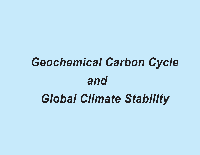 | Here
are teaching slides for "Geochemical carbon cycle and global climatic
stability". You can see a full-size version by clicking on the thumbnail.
You can then download that slide individually by right mouse clicking
on it; using the "Save As" command in the File menu; or in most cases,
by simply dragging it to your desktop.
|
|
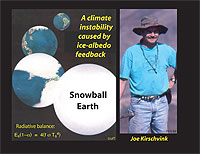 | 8.2:
When climate physicists discovered the ice-albedo instability through energy-balance
calculations in the 1960’s, they assumed that the ice-covered planet
would be stable in perpetuity on account of its high albedo. Kirschvink
(1992), building on concepts developed by the planetary atmosphere chemist
James C.G. Walker and associates in the 1980’s, proposed that a “snowball
earth” (his name) was self-reversing because of silicate-weathering
feedback in the tectonically-driven carbon cycle.
|
|
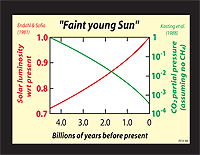 | 8.3:
Modeled increase in Solar luminosity over geologic time (Endahl & Sofia,
1981) and the compensatory decrease in atmospheric CO2 partial pressure
(assuming
negligible methane) required if surface temperatures were quasi-stable
over billions of years as is observed geologically.
|
|
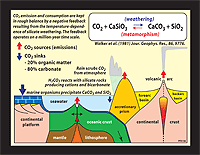 | 8.4:The
geochemical carbon cycle showing major sources and sinks of carbon dioxide
to the ocean-atmosphere system. Silicate weathering feedback adjusts atmospheric
CO2 level to balance CO2 sources and sinks. Plate tectonics recycles sedimentary
carbon (carbonate and organic matter) as volcanic and metamorphic CO2.
|
|
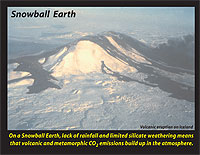 | 8.5:
Volcanic eruption on Iceland during winter.
|
|
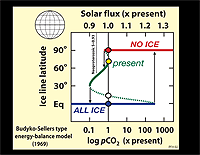 | 8.6:
Ice-line latitude on an all-ocean planet as a function of the Solar flux
(the observed
interannual variability of which is <0.1%) and the equivalent CO2 radiative
forcing (the “greenhouse” effect), according to simple energy-balance
calculations of the Budyko-Sellers type. If radiative forcing declined,
ice lines follow the solid green line until they reach ~30Å latitude, after
which ice-albedo feedback is self-sustaining and ice lines move rapidly
(<103 years) to the equator (snowball earth). After millions of years,
dependent on the magnitude of the CO2 hysteresis loop, normal volcanic
outgassing combined with reduced silicate weathering causes CO2 to reach
the critical level for deglaciation. Meltdown occurs rapidly (<104,
driven by reverse ice-albedo and other feedbacks, resulting in an ice-free
state with greatly elevated CO2, which takes 105 to 107 years to draw down
through silicate weathering of the glaciated landscape.
|
|
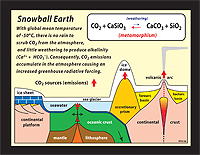 | 8.7:
The geochemical carbon cycle on a snowball Earth. Volcanic and metamorphic CO2 sources continue unaffected, but removal of CO2 from the atmosphere
is limited by the absence of rainfall. Silicate weathering is reduced by ice cover and cold ground temperatures.
|
|
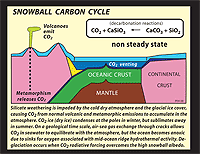 | 8.8:
Tectonically-driven carbon cycle on a snowball earth, where volcanism continues
to emit CO2
into the atmosphere and ocean, but CO2 consumption is limited
by the absence of rainfall and by cold-base ice.
|
|
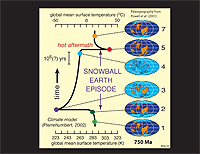 | 8.9:
Hypothetical depiction of the Sturtian snowball earth scenario in terms
of global mean
surface temperature (Pierrehumbert, 2002) and ice cover (pale blue) on
a 750-Ma paleogeography (Powell et al., 2001). Note abrupt onset and termination
of glaciation at low-latitudes, and the hot aftermath due to CO2.
Temperature rise during snowball interval is non-linear due to non-linear
CO2 radiative
forcing.
|









